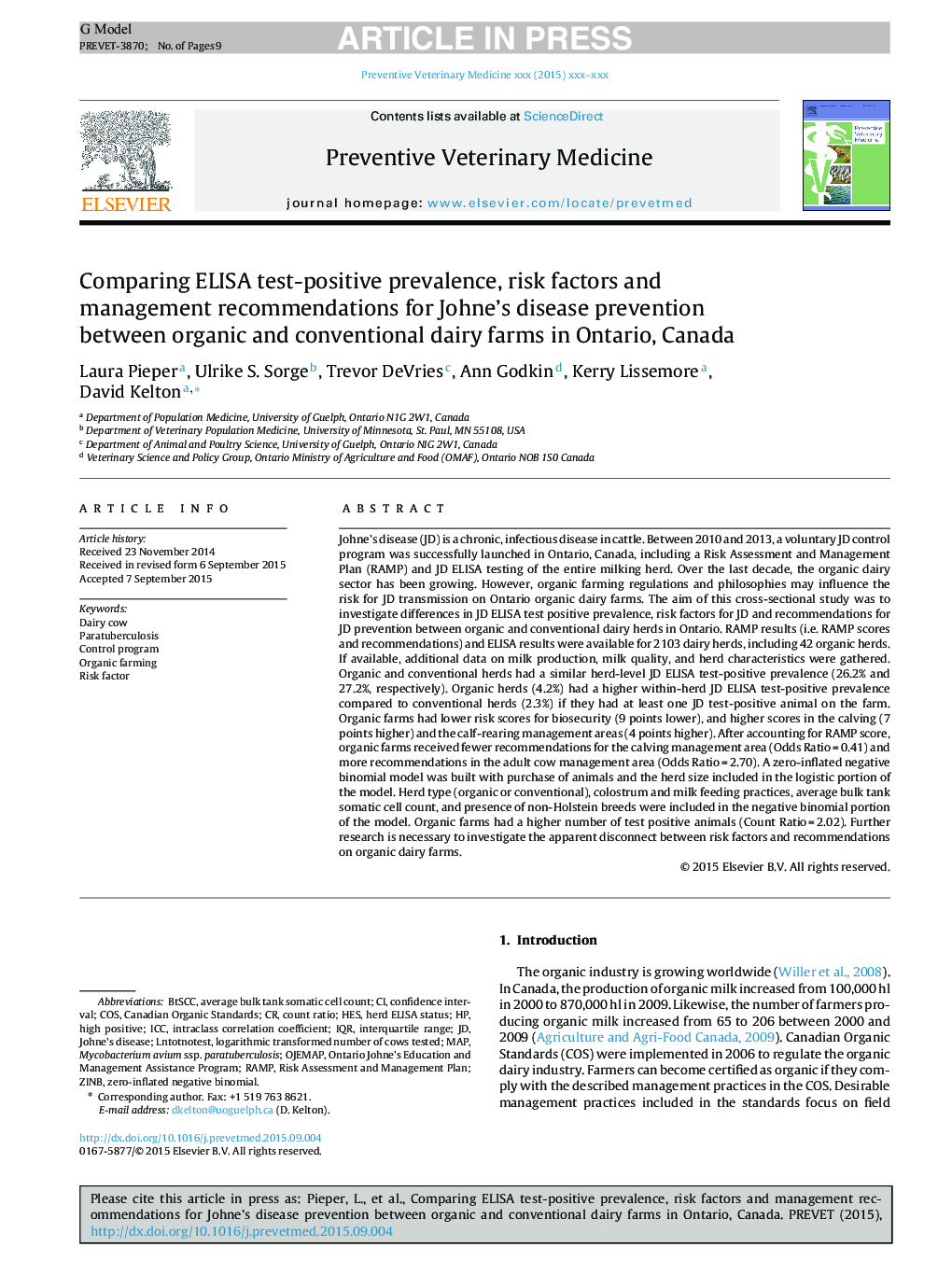| کد مقاله | کد نشریه | سال انتشار | مقاله انگلیسی | نسخه تمام متن |
|---|---|---|---|---|
| 5793066 | 1554166 | 2015 | 9 صفحه PDF | دانلود رایگان |
عنوان انگلیسی مقاله ISI
Comparing ELISA test-positive prevalence, risk factors and management recommendations for Johne's disease prevention between organic and conventional dairy farms in Ontario, Canada
دانلود مقاله + سفارش ترجمه
دانلود مقاله ISI انگلیسی
رایگان برای ایرانیان
کلمات کلیدی
BtSCCMycobacterium avium ssp. paratuberculosisICCIQRCOSHES - او هستControl program - برنامه کنترلJohne’s disease - بیماری جونZero-inflated negative binomial - دوقطبی منفی بدون صفرramp - رمپZINB - زینبintraclass correlation coefficient - ضریب همبستگی داخل کلاسیRisk factor - عامل خطرconfidence interval - فاصله اطمینانinterquartile range - محدوده بین محدبmap - نقشهParatuberculosis - پاراتوبرکلوزیس Organic farming - کشاورزی زیستیDairy cow - گاو شیری
موضوعات مرتبط
علوم زیستی و بیوفناوری
علوم کشاورزی و بیولوژیک
علوم دامی و جانورشناسی
پیش نمایش صفحه اول مقاله

چکیده انگلیسی
Johne's disease (JD) is a chronic, infectious disease in cattle. Between 2010 and 2013, a voluntary JD control program was successfully launched in Ontario, Canada, including a Risk Assessment and Management Plan (RAMP) and JD ELISA testing of the entire milking herd. Over the last decade, the organic dairy sector has been growing. However, organic farming regulations and philosophies may influence the risk for JD transmission on Ontario organic dairy farms. The aim of this cross-sectional study was to investigate differences in JD ELISA test positive prevalence, risk factors for JD and recommendations for JD prevention between organic and conventional dairy herds in Ontario. RAMP results (i.e. RAMP scores and recommendations) and ELISA results were available for 2103 dairy herds, including 42 organic herds. If available, additional data on milk production, milk quality, and herd characteristics were gathered. Organic and conventional herds had a similar herd-level JD ELISA test-positive prevalence (26.2% and 27.2%, respectively). Organic herds (4.2%) had a higher within-herd JD ELISA test-positive prevalence compared to conventional herds (2.3%) if they had at least one JD test-positive animal on the farm. Organic farms had lower risk scores for biosecurity (9 points lower), and higher scores in the calving (7 points higher) and the calf-rearing management areas (4 points higher). After accounting for RAMP score, organic farms received fewer recommendations for the calving management area (Odds Ratio = 0.41) and more recommendations in the adult cow management area (Odds Ratio = 2.70). A zero-inflated negative binomial model was built with purchase of animals and the herd size included in the logistic portion of the model. Herd type (organic or conventional), colostrum and milk feeding practices, average bulk tank somatic cell count, and presence of non-Holstein breeds were included in the negative binomial portion of the model. Organic farms had a higher number of test positive animals (Count Ratio = 2.02). Further research is necessary to investigate the apparent disconnect between risk factors and recommendations on organic dairy farms.
ناشر
Database: Elsevier - ScienceDirect (ساینس دایرکت)
Journal: Preventive Veterinary Medicine - Volume 122, Issues 1â2, 1 November 2015, Pages 83-91
Journal: Preventive Veterinary Medicine - Volume 122, Issues 1â2, 1 November 2015, Pages 83-91
نویسندگان
Laura Pieper, Ulrike S. Sorge, Trevor DeVries, Ann Godkin, Kerry Lissemore, David Kelton,